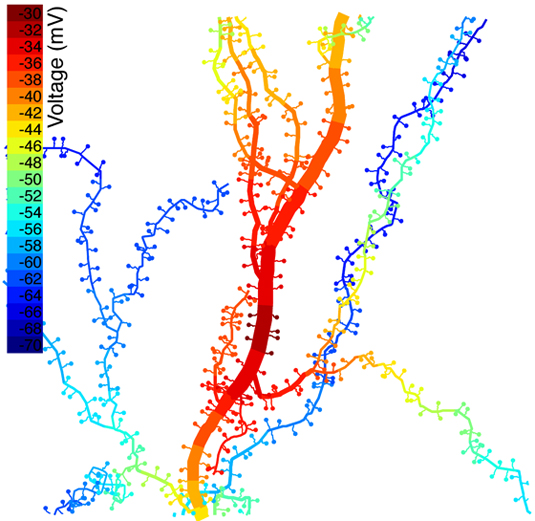After 100 Years, Understanding the Electrical Role of Dendritic Spines
Researchers make discoveries about the workings of the brain
It’s the least understood organ in the human body: the brain, a massive network of electrically excitable neurons, all communicating with one another via receptors on their tree-like dendrites. Somehow these cells work together to enable great feats of human learning and memory. But how?
Researchers know dendritic spines play a vital role. These tiny membranous structures protrude from dendrites’ branches; spread across the entire dendritic tree, the spines on one neuron collect signals from an average of 1,000 others. But more than a century after they were discovered, their function still remains only partially understood.
A Northwestern University researcher, working in collaboration with scientists at the Howard Hughes Medical Institute (HHMI) Janelia Farm Research Campus, has recently added an important piece of the puzzle of how neurons “talk” to one another. The researchers have demonstrated that spines serve as electrical compartments in the neuron, isolating and amplifying electrical signals received at the synapses, the sites at which neurons connect to one another.
The key to this discovery is the result of innovative experiments at the Janelia Farm Research Campus and computer simulations performed at Northwestern University that can measure electrical responses on spines throughout the dendrites.
 A paper about the findings, “Synaptic Amplification by Dendritic Spines Enhances Input Cooperatively,” was published November 22 in the journal Nature.
A paper about the findings, “Synaptic Amplification by Dendritic Spines Enhances Input Cooperatively,” was published November 22 in the journal Nature.
“This research conclusively shows that dendritic spines respond to and process synaptic inputs not just chemically, but also electrically,” said William Kath, professor of engineering sciences and applied mathematics at Northwestern’s McCormick School of Engineering, professor of neurobiology at the Weinberg College of Arts and Sciences, and one of the paper’s authors.
Dendritic spines come in a variety of shapes, but typically consist of a bulbous spine head at the end of a thin tube, or neck. Each spine head contains one or more synapses and is located in very close proximity to an axon coming from another neuron.
Scientists have gained insight into the chemical properties of dendritic spines: receptors on their surface are known to respond to a number of neurotransmitters, such as glutamate and glycine, released by other neurons. But because of the spines’ incredibly small size — roughly 1/100 the diameter of a human hair — their electrical properties have been harder to study
In this study, researchers at the HHMI Janelia Farm Research Campus used three experimental techniques to assess the electrical properties of dendritic spines in rats’ hippocampi, a part of the brain that plays an important role in memory and spatial navigation. First, the researchers used two miniature electrodes to administer current and measure its voltage response at different sites throughout the dendrites.
They also used a technique called “glutamate uncaging,” a process that involves releasing glutamate, an excitatory neurotransmitter, to evoke electrical responses from specific synapses, as if the synapse had just received a signal from a neighboring neuron. A third process utilized a calcium-sensitive dye — calcium is a chemical indicator of a synaptic event — injected into the neuron to provide an optical representation of voltage changes within the spine.
At Northwestern, researchers used computational models of real neurons — reconstructed from the same type of rat neurons — to build a 3D representation of the neuron with accurate information about each dendrites’ placement, diameter, and electrical properties. The computer simulations, in concert with the experiments, indicated that spines’ electrical resistance is consistent throughout the dendrites, regardless of where on the dendritic tree they are located.
While much research is still needed to gain a full understanding of the brain, knowledge about spines’ electrical processing could lead to advances in the treatment of diseases like Alzheimer’s and Huntington’s diseases.
“The brain is much more complicated than any computer we’ve ever built, and understanding how it works could lead to advances not just in medicine, but in areas we haven’t considered yet,” Kath said. “We could learn how to process information in ways we can only guess at now.”
Other authors of the paper, all of HHMI Janelia Farm Research Campus, include lead author Mark T. Harnett, Judit K. Makara, Nelson Spruston (formerly of Northwestern University), and Jeffrey C. Magee, the senior author on the paper.
